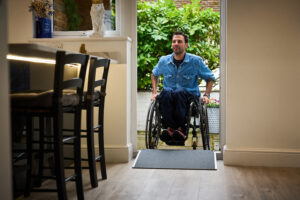
We know that when assessing for a ramp you need to take the key measurements of the application, for example the height of the step, but it’s also very important to consider the end user’s circumstances to find the ramp that’s best for them, and will maximise their freedom within their budget.
The key factors to consider to help you achieve this are:
Always remember to consider what mobility device the end user will be using on the ramp. For example, if the end user has a three-wheel scooter or rollator, a full width ramp will be a much better solution than a pair of channel ramps.
Don’t forget – this quickly adds up, especially with heavy mobility scooters or assisted powered wheelchair combinations. Is this within the capacity of the ramp?
If independent access is required it is recommended that you look at a gradient of 1:15 or 1:12, which means you will need a longer ramp. The user may need handrails as well, so an installed ramp system is often most appropriate.
Take into account the fact that the person lifting and deploying the ramp could be the end user, or an elderly carer who may have limited strength themselves. If the weight of the ramp could be an issue, it may be best to consider a modular installed ramp, or a pair of channel ramps, or a two-part full-width multi-folding ramp so that only half of the ramp needs to be lifted at a time.
Think – could the same ramp that is used for access at the front door also be used for getting into the car, or out of the back door and into the garden?
It’s important to take into account whether the end user’s mobility will ultimately improve or decline. For example, you may be required to specify a ramp for someone who is currently in a wheelchair, but hopes to progress to crutches in the future. In this case, it would be best to specify a full-width ramp, as channel ramps are not so suitable for use with crutches.
If you take into account all of these considerations, as well as collecting all the relevant location and environment information for the end user’s application, you will be well set up for providing excellent ramp assessments and selecting the best ramp for your client every time. If you get a tricky application that you would like some assistance with, contact us and we’ll do our best to help!
Take a look at our blog on the location and environment information to collect when you’re assessing for a ramp here, and download our simple ramp assessment checklist here.
Next in the Wheelchair Ramp Assessing series: